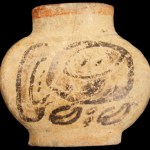archaeology
The recent launch of the Curiosity Mars rover has quietly broken the record for oldest human-made object in space, and instantly pulled numismatics, the study of coinage, into the Space Age.
Prior to the launch, the oldest human-made object in space was the Vanguard 1 satellite, which was launched in 1958 and operated until 1964. Now it is a coin!
American geologists have long used copper Lincoln pennies as scale indicators in photographs. All the Mars rover missions are geology projects conducted at a distance. And so, as a homage to professional geology tradition, a 1909 one-cent coin is…
Dear Reader Fiona asked me to write more about archaeology, which reminded me that I haven't said much about what I've been doing in my study these past months. I find that the last time was actually in late August when I dug in the cave with Margareta and Magdalena.
So, what have I been up to during these months when no Swedish archaeologist wants to do fieldwork? I have:
Written the archive reports on my 2011 fieldwork.
Checked for fits between some copper alloy fragments we picked up at an Uppland hoard site and the hoard itself in the Historical Museum. We found no fits but two likely…
British Archaeology #122 (Jan/Feb) has a good feature on the origins of Roman London, presenting and collating evidence from excavations in the 90s and 00s for a military camp immediately post-dating the AD 43 invasion of Britain. The editors have slapped a silly headline on the thing though, playing up a short passage about human heads deposited in the Walbrook stream as if this were the main issue dealt with in the piece.
The unsigned last page discusses the important work of Raimund Karl (in The Historic Environment: Policy & Practice Oct 2011; read it on-line), who has compared the…
Over the last few weeks I've run into a few misconceptions about tobacco, as well as some interesting news, so I thought I'd share. If you already know some of this, forgive me, not everyone else does.
First, tobacco, Nicotiana tabacum, is a member of the Solanaceae family of plants, which from a human perspective has got to be one of the most interesting plant families out there. It includes Belladonna, peppers, potatoes, and tomatoes. So, from this one family of plants, you can kill your neighbor, have a nice meal, and a smoke a cigar afterward.
Tobacco is a Native American cultivar.…
Plaster from human dwellings or the signs of a long-abandoned animal enclosure? Tuesday's New York Times describes the collaboration between a chemist - structural biologist Prof. Steve Weiner, who is head of the Helen and Martin Kimmel Center for Archaeological Science at the Weizmann Institute - and American archaeologists. From China to the nearby site of biblical Gath, Weiner and his team have been applying the methods of advanced chemistry to solving riddles of the ancient world. (The answer, at least for the dig at Ashkelon, is fecal and decayed plant matter, meaning the apparent palace…
My current project on the siting of Bronze Age sacrificial sites aims to rediscover some of the the period's landscape rules. In other words, I'm building an heuristic model which might allow archaeologists to search actively for such sites instead of waiting for farmers and drainage workers to find them by chance. I was encouraged to read the following in David Yates' and Richard Bradley's paper "The siting of metalwork hoards in the Bronze Age of south-east England" (Antiquaries Journal 90, 2010).
"For some time it has been obvious that metal detectorists have been extraordinarily fortunate…
Here I go again, bad-mouthing Thor Heyerdahl to his countrymen. But note that I'm quoted as saying, "Norway is a country that has produced many great archaeologists. Thor Heyerdahl was not one of them." Proud Norwegians, your country is great! And its greatness does not hinge upon the posthumous judgment of that guy with the raft.
Hear the audio clip here.
Update same day: Hehe. Some commenters on the NRK website are offended. One feels that I am just a kid with a lot of opinions, which is rather flattering to this balding father of a teen. Another thinks I'm just trying to become famous in…
Sweden's goodbye to religious faith and cult continues apace, and so does the relocation of the population from the countryside to the cities. Here's a sign of the times. The National Heritage Board has recently re-issued its 1998 how-to guide for (rural) congregations who wish to quit heating their churches (available as a free PDF).
Sweden's rural churches, many of which were built in the 12th, 13th and 14th centuries, have only been heated for the past century or so. It's comfier for the congregants and it reduces humidity, thus improving preservation conditions for some materials. But…
Here's a cool new detector find from Hvirring in central Jutland, Denmark. I've never seen a piece like this before: measuring only 45 mm in length, it must be a top mount for something - box, horse yoke, staff? But the motif, four dancing gripping beasts, and the style they're executed in, place the thing firmly in the 9th century. Note the little round ears and the cross-hatching on chest and rump.
Thanks to Dear Reader Jakob for the tip-off.
Current Archaeology #260 (November) has a piece on the Roman baby burials at Yewden villa in England. Excavated in the 1910s, they have long been suspected to represent infanticide. Now Simon Mays has been able to prove that this is indeed the case by means of new osteological methods and comparison with other burial sites. People have wondered if the site was a military brothel. Since it's a rural high-status habitation, this seems rather unlikely. But Mays suggests that if the child murders were spread out over three centuries, what sets Yewden apart is mainly the tenacity of the custom.…
I've written before about the archaeological landscape surrounding Arlanda International Airport north of Stockholm. Following on yesterday's post about the fake archaeology in Oslo airport, here's a piece of landscape that has been moved inside Arlanda's terminal 2. It's an 11th century runestone commemorating one of the men who died on Ingvar the Far-travelled's disastrous expedition to the east. The stone was found in 2000 when the road to the airport was widened, suggesting an impressive age for the road. Placing the runestone in the airport terminal ensures its protection from the rain…
I've written a bit before about Thor Heyerdahl's hyperdiffusionism and the status as a Norwegian national hero he still enjoys despite being completely discounted as a scientist. Last time I passed through Oslo airport I discovered this Kon Tiki-themed restaurant with a faux Ecuadorian Bolivian stele. I think what Heyerdahl interpreted as a full beard is more likely to depict a decorative face plate hanging from the man's nose. And anyway, a beard is of course not evidence that a man is a civilisation-bearing Ãbermensch from Europe.
Tradition. Not just a song from Fiddler on the Roof.
You know the refrain: "The Papa, the Papa! Tradition." It's a great play but it is firmly rooted in the patriarchy, as "tradition" often is.
There are many ways to define "tradition" and we can look it up somewhere and have a flameware over dictionary meanings if you want. But instead I'll tell you what I think the word means, roughly, generally, and subject to revision.
First, "tradition" is a feature of culture that simply refers to practices that are habitual. A subset of "traditions" are formalized or regularized, like holidays in…
The Kensington runestone of Minnesota is a rather obvious 19th century fake. But in a recent paper in Saga och Sed 2010, Mats G. Larsson shows something less obvious: the hidden signature of the stone's carver, who also was its finder.
Olof Ãhman came from Forsa in Hälsingland, central Sweden. He claimed to have found the stone among the roots of an aspen tree he had felled with his son. Now Larsson points to the unique rune for à on the stone, which is an O with a small N inside. This looks a lot like O-n, an abbreviation of the man's surname. And as it turns out, Ãhman came from a…
If we look only at contemporaneous written evidence and disregard kings, Iarlabanki Ingefastson is probably the most copiously documented Scandinavian of the Viking Period. But his name does not occur even once on vellum. His memory lives entirely in the many rune stones he commissioned.
Iarlabanki (Jarlabanke in modern Swedish) was a major landowner in Uppland north of Stockholm, and his lifetime happened to coincide with the great mid-to-late-11th century rune stone craze in that province. Iarlabanki was a Christian, probably only of the third generation, and like other monuments of the…
Fornvännen 2011:1 is half a year old, and so has been published as an open-access full-text journal. Six months is the Berlin Declaration's limit for what qualifies as Open Access. Check it out!
Joakim Goldhahn on early Swedish rock art documentation
Frans-Arne Stylegar et al. on two bronze masks from Avaldsnes in western Norway that look Celtic and may thus either be pre-Roman or Viking in date
Jonas Monié Nordin on rural Medieval social/religious guilds
Sonja Hukantaival on Finnish folk magic as seen in archaeology and early folklore documentation
Sven-Gunnar Broström et al. on new…
German archaeologist Herbert Jankuhn (1905-90) is a contentious figure. A passionate Nazi soldier and SS archaeologist up until 1945, he became one of the country's most influential post-war archaeologists from the late 50s onward. Fornvännen 2011:3 has just come out containing a contribution on the younger Jankuhn's heartfelt Nazi enthusiasm, as documented by recent archive finds.
I'm reading Wolf-Dieter Tempel's charming professional memoir, Am Rande der Archaäologie. Here's a wonderful snippet from his recollections regarding Jankuhn, who was his teacher (and I translate).
The Göttingen…
Yesterday my dad had his boat lifted out of the water like he does every autumn to keep the ice from damaging it. I hadn't seen the lift they used before: it's a remote-controlled motorised thing, fast and nifty. Note the yellow control box.
This reminded me of a fairly common motif in Bronze Age rock art, the boat carrier. Boats are extremely common, and sometimes you'll find a guy lifting the boat, crew and all. I think this is probably a depiction of the Sea God. But it may also be a human lifting a wooden ship model. We have a few bronze figurines that look like they may have adorned…
Back in February I wrote about a new issue of Halland County Museum's periodical Utskrift. And now I have already received two new issues! I'll talk a little about #12 here as I haven't read #11 yet.
The volume is an homage to Lennart Lundborg on his 80th birthday. Lundborg is a beloved figure in Halland archaeology and a former employee of the museum. Fittingly, five of the twelve papers deal with the Bronze Age in Halland province, the man's main field of study, and three with other aspects of his work, including the many comics he's drawn!
The three longest papers (all 14 pp.) are a report…
As noted before here on Aard, last winter a man handed in a 2nd century Roman cavalry parade mask to the authorities on Gotland, an island province of Sweden in the Baltic Sea. He says it was found illicitly in the 1980s by a recently deceased metal detectorist. The old man in question was a known nighthawk, and seems to have stuck a spade right through the mask when digging it out. Yet the mask has an excellent find context. The owner pointed to a Late Roman / Migration Period house foundation, my Visby colleagues excavated part of it this past summer, and they found a mixed metalwork hoard…

